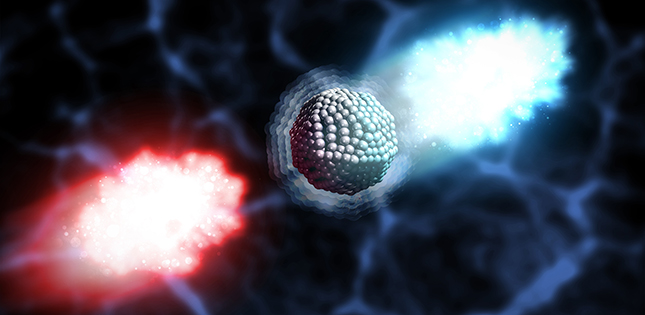
Tiniest Particles Shrink Before Exploding When Hit With SLAC's X-ray Laser

Copyright : SLAC National Accelerator Laboratory
Researchers assumed that tiny objects would instantly blow up when hit by extremely intense light from the world's most powerful X-ray laser at the Department of Energy's SLAC National Accelerator Laboratory in the United States.
But to their astonishment, these nanoparticles initially shrank instead – a finding that provides a glimpse of the unusual world of superheated nanomaterials that could eventually also help scientists further develop X-ray techniques for taking atomic images of individual molecules.
The experiments took place at the Linac Coherent Light Source (LCLS) X-ray laser, a DOE Office of Science User Facility. Its pulses are so bright that they can be used to turn solids into highly ionized gases, or plasmas, that blow up within a fraction of a second.
Fortunately, for many samples researchers can take the data they need before the damage sets in – an approach that has been used to reveal never-before-seen details of a variety of samples relevant to chemistry, materials science, biology and energy research.
The ultimate limits of this approach are, however, not well understood. One of the key visions for X-ray laser science is to image individual, one-of-a-kind particles with single X-ray pulses. To do so in a quantitative manner, researchers need to understand precisely how each molecule responds to the intense X-ray light. The new study, published in Science Advances, provides an unexpected insight into this aspect.
“So far, all models have assumed that a very small system would immediately explode when we pump a lot of energy into it with the X-ray laser,” says former LCLS researcher Christoph Bostedt, who is now at Argonne National Laboratory and Northwestern University. “But our experiments showed otherwise.”
At LCLS, Bostedt and his fellow researchers exposed minuscule clusters of xenon atoms to two consecutive X-ray pulses. The clusters, which were merely three millionths of an inch across, were heated by the first pulse for 10 quadrillionths of a second, or 10 femtoseconds. The second pulse then probed the clusters' atomic structures over the next 80 femtoseconds.
“The unique nature of the LCLS X-ray pulse allowed us to create a freeze-frame movie of the response, with a resolution of about a tenth of the width of a single xenon atom,” says LCLS and Stanford University graduate student Ken Ferguson, who led the data analysis. The researchers believe that the effect is a result of how electrons, which were initially localized around individual xenon atoms, redistribute over the entire cluster after the first X-ray pulse.
“This phenomenon had never been observed before, nor had it been predicted by any of the existing theories,” he says. “We expect it to have implications for many ultrafast X-ray laser experiments, especially those geared toward single-particle imaging with very intense X-ray pulses.”
The research could benefit studies in other areas as well, such as investigations of warm dense matter – a state of matter between a solid and a plasma that exists in the cores of certain planets and is also important in the pursuit of nuclear fusion with high-power lasers.
Other institutions involved in the study were Technical University of Berlin, Germany; Tohoku University, Japan; National Science Foundation BioXFEL Science and Technology Center, Buffalo; and Kyoto University, Japan.
This text and images for this release were provided by the SLAC National Accelerator Laboratory.
Publication Details:
Authors: Ken R. Ferguson, Maximilian Bucher, Tais Gorkhover, Sébastien Boutet, Hironobu Fukuzawa, Jason E. Koglin, Yoshiaki Kumagai, Alberto Lutman, Agostino Marinelli, Marc Messerschmidt, Kiyonobu Nagaya, Jim Turner, Kiyoshi Ueda, Garth J. Williams, Philip H. Bucksbaum and Christoph Bostedt
Title: Transient lattice contraction in the solid-to-plasma transition
Journal: Science Advances 29 Jan 2016
DOI: 10.1126/sciadv.1500837
About SLAC National Accelerator Laboratory:
SLAC National Accelerator Laboratory
SLAC is a multi-program laboratory exploring frontier questions in photon science, astrophysics, particle physics and accelerator research. Located in Menlo Park, Calif., SLAC is operated by Stanford University for the U.S. Department of Energy's Office of Science.
SLAC National Accelerator Laboratory is supported by the Office of Science of the U.S. Department of Energy. The Office of Science is the single largest supporter of basic research in the physical sciences in the United States, and is working to address some of the most pressing challenges of our time. For more information, please visit science.energy.gov.
Contact:
Kiyoshi Ueda
Institute of Multidisciplinary Research for Advanced Materials
University of Tohoku University
Email: uedatagen.tohoku.ac.jp
Associated links
Original article from Tohoku University












